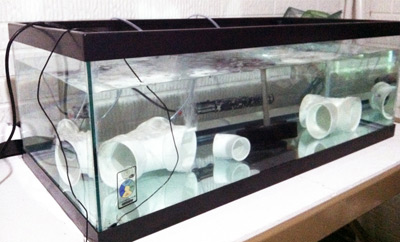When it comes to stocking a saltwater aquarium, there is one irrefutable truth every hobbyist must learn and take to heart—introducing livestock to a display tank without quarantining it first is a surefire recipe for failure. Trust your friends here at Saltwater Smarts when we say that if you habitually skip quarantine, it’s not a question of if disaster will strike, but when!
What is quarantine and why do it?
Quarantine is simply a period of isolation in a separate aquarium system. Its purpose is fourfold:
- It provides an opportunity to observe specimens for signs and symptoms of disease or parasites. (You don’t want to discover these after a sick specimen has been introduced to your display tank and infected all your other fish!)
- The quarantine tank can be converted quickly to a hospital tank for administering treatments and therapies to sick fish.
- It’s a good opportunity for new specimens to recuperate fully after the rigorous journey from the ocean to your home and before they have to compete with tankmates.
- It’s the perfect environment for getting fish accustomed to a captive diet and enticing finicky or hunger-striking specimens to start eating.
What should be included in the quarantine tank?
Okay, you’re in the process of setting up a brand new saltwater system, and now we’re asking you to throw an additional setup into the mix? How costly and complicated is this going to get? Fear not! A quarantine tank does not have to be especially large, expensive, or equipment-intensive.
All you need is a tank, heater, filter (e.g., a sponge filter or hang-on-tank power filter), possibly a powerhead for circulation, and some sort of cover so the fish can hide. Sections of PVC pipe work very well for this purpose and are very easy to clean. Lighting is optional—but definitely helpful for observing symptoms. Inexpensive, normal-output fluorescents will do just fine. If a cover is needed to keep a skittish fish from jumping, inexpensive egg crate light-diffusing material (available at any home-improvement store) can be cut to fit the top of the tank.
Biological filtration can be provided in a variety of ways. For instance, you can use a sponge filter or other biofiltration medium that is kept in a mature system between uses (and hence is already inoculated with nitrifying bacteria). Or, you can borrow a few chunks of fully cured live rock from another system and place them in the quarantine tank.
How big should the system be?
Oftentimes, new hobbyists are told that a quarantine tank doesn’t have to be any larger than 10 gallons. While a tank this size will suffice for very small specimens, it simply won’t be adequate for medium-sized to large specimens and all the waste products they generate. We’ve found that something in the range of a standard 29-gallon tank is just about the right minimum size for most specimens available on the market.




If you use a quarantine tank I would not put in live rock or any type of filter. I prefer to just change maybe 25% of the water every day with water from your main reef. This has a couple of benefits, it gets the fish used to your tank water, and it keeps it’s water clean without the need to cycle a quarantine tank. Replace your tank water with new water so you can call it a slow water change.
Thank you so much! the best idea for QT water change ever!
One thing I would add is an ammonia detector. I saw one in the picture but you didn’t mention it.
I’ve been using Chloroquine Phosphate to treat Cryptocaryon (marine ich) in QT. I also had a severe breakout and it’s no fun trying to get rid of. Trying to catch fish in a rock filled display is hard so it’s best to treat fish before introducing them in DT. I’m now a firm believer in QT!!!
Both great points, Tim! Thanks for sharing these suggestions.
While a quarantine tank is a good idea, I personally have had more success without one. Why? Two reasons mainly: 1. The temperature is controlled in my display tank only. No chiller for hospital tank and livestock was stressed out and died! 2. Biological environment in display tank is supportive more than no biological in quarantine tank is. No deep sand bed/live rock. So for the last five years my 75gal saltwater reef tank has had 1 death..nemo committed suicide. I’d say that’s proof enough not to use a hospital/quarantine tank. All my other fish have been doing great!
Thanks for sharing your experiences, John! There’s no question that a quarantine tank won’t do its intended job unless it provides suitable water parameters and biological filtration.
As I touched upon in the post, if I know I’ll be acquiring new specimens in the future, I usually put some rocks in the sump of my display tank several weeks in advance so they have a chance to become seeded with nitrifying bacteria. Then I move them to the quarantine tank as soon as I get the new fish home.
If I don’t have that much time on my hands, I’ll sometimes pull a few chunks of live rock from my display tank to provide biofiltration in quarantine. Then, if the fish prove to be healthy and no treatment is necessary, I’ll put the rocks back in the display.
I haven’t always been so fanatical about quarantine, but I became so after going through an extremely frustrating Cryptocaryon outbreak in my display tank. That’s an experience I never want to repeat!